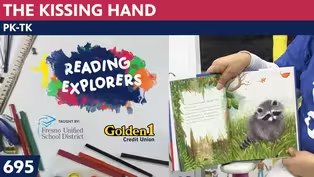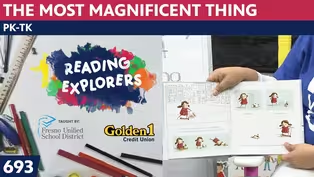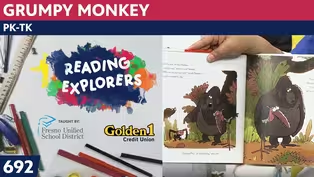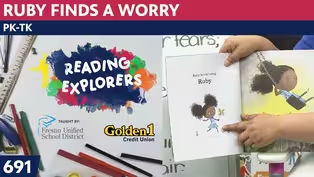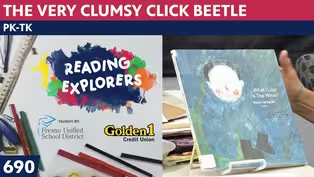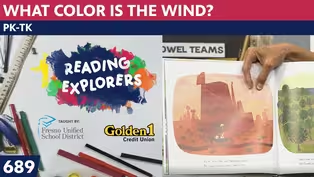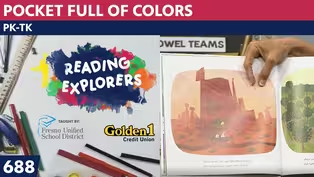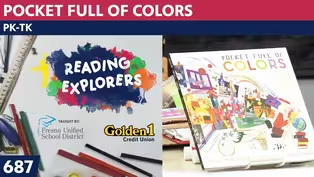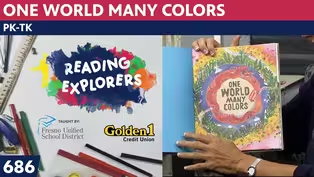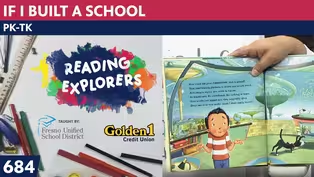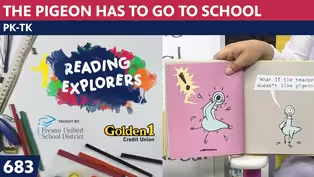
TK-353: Henri Matisse
Season 3 Episode 294 | 14m 12sVideo has Closed Captions
Join Mrs. Readwright at Camp Discovery!
Transitional Kindergarten teacher, Mrs. Readwright, welcomes students back to Camp Discovery, a fun learning space packed with reading adventures & fun games!
Problems playing video? | Closed Captioning Feedback
Problems playing video? | Closed Captioning Feedback
Reading Explorers is a local public television program presented by Valley PBS

TK-353: Henri Matisse
Season 3 Episode 294 | 14m 12sVideo has Closed Captions
Transitional Kindergarten teacher, Mrs. Readwright, welcomes students back to Camp Discovery, a fun learning space packed with reading adventures & fun games!
Problems playing video? | Closed Captioning Feedback
How to Watch Reading Explorers
Reading Explorers is available to stream on pbs.org and the free PBS App, available on iPhone, Apple TV, Android TV, Android smartphones, Amazon Fire TV, Amazon Fire Tablet, Roku, Samsung Smart TV, and Vizio.
Providing Support for PBS.org
Learn Moreabout PBS online sponsorshipMore from This Collection
Valley PBS and Fresno Unified School District have partnered with Golden 1 Credit Union to create Reading Explorers Lessons for grades Pre-Kindergarten through Third grade. The daily lessons will be taught by Fresno Unified School District teachers and are created to help students practice their reading skills and reinforce lessons during distance learning.
Video has Closed Captions
Valley PBS presents Reading Explorers Lessons for Pre-Kindergarten and TK. (26m 27s)
PK-TK-693-The Most Magnificent Thing
Video has Closed Captions
Valley PBS presents Reading Explorers Lessons for Pre-Kindergarten and TK. (26m 26s)
Video has Closed Captions
Valley PBS presents Reading Explorers Lessons for Pre-Kindergarten and TK. (26m 28s)
Video has Closed Captions
Valley PBS presents Reading Explorers Lessons for Pre-Kindergarten and TK. (26m 28s)
PK-TK-690: The Very Clumsy Click Beetle
Video has Closed Captions
Valley PBS presents Reading Explorers Lessons for Pre-Kindergarten and TK. (26m 22s)
PK-TK-689: What Color is the Wind?
Video has Closed Captions
Valley PBS presents Reading Explorers Lessons for Pre-Kindergarten and TK. (26m 21s)
PK-TK-688: Pocket Full of Colors
Video has Closed Captions
Valley PBS presents Reading Explorers Lessons for Pre-Kindergarten and TK. (25m 58s)
PK-TK-687: Dancing Through Fields of Colors
Video has Closed Captions
Valley PBS presents Reading Explorers Lessons for Pre-Kindergarten and TK. (26m 20s)
PK-TK-686: One World Many Colors
Video has Closed Captions
Valley PBS presents Reading Explorers Lessons for Pre-Kindergarten and TK. (27m 13s)
PK-TK-685: School is Wherever I am
Video has Closed Captions
Valley PBS presents Reading Explorers Lessons for Pre-Kindergarten and TK. (26m 32s)
PK-TK-684: If I Built a School
Video has Closed Captions
Valley PBS presents Reading Explorers Lessons for Pre-Kindergarten and TK. (26m 21s)
PK-TK-683: The Pigeon Has to Go to School
Video has Closed Captions
Valley PBS presents Reading Explorers Lessons for Pre-Kindergarten and TK. (26m 22s)
Providing Support for PBS.org
Learn Moreabout PBS online sponsorship(lighthearted guitar music) ♪ Good morning to a brand new day ♪ ♪ Time to learn and games to play ♪ ♪ Learning things is so much fun ♪ ♪ Learning is good for everyone ♪ (cheerful music) - Hello, early learners.
Welcome back to the art room.
It's me Mrs. Readwright.
This week, we've been talking about letters and letters of alphabet and art.
And we started out with doing a hello song that's really a let's make some noise song.
And I warned people don't do too much noise if people are sleeping in your house.
But look at this interesting instrument it's like a chameleon or a lizard, his head and then the middle of his body is the instrument and his tail is the other end.
And I turn it over this way (playing the instrument) to do this so we can sing.
♪ Let's make some noise ♪ ♪ We girls and boys ♪ ♪ Let's make some noise ♪ ♪ So, we've got a voice ♪ (playing the instrument) Alrighty.
And today is letter W, let's sing the song about the letters, ready?
♪ A B, C, D E of art.
♪ ♪ That's the way that we will start ♪ ♪ U for umbrella violin for V ♪ ♪ W for window we can see ♪ ♪ X is for X ♪ ♪ Y yarn squiggles for me ♪ ♪ Warhol, zebra ends the alphabet with Z.
♪ Now, today we're talking about our old friend Henri Matisse.
Remember when he started out as a painter and then he went to cutting out paper collages because his legs weren't working very well anymore but he was also famous for being one of the fauves and fauve means wild beast.
And during that time his paint brush strokes were very thick and he didn't mix the paints very much.
It just paint, paint, paint, paint and he left those short little strokes in there.
So I'm going to try to do that today while I make the open window.
That's the paint today.
W is for window through the open window to the sail boats below Matisse's bright colors, put on quite a show.
Now Matisse, every summer would go to be by the Mediterranean sea.
And when he would look out his window he would see beautiful sites and he would paint them so that he would remember.
So, these shutters are open and they have the glass in them.
We're going to be drawing those.
I'm going to use my background paper and put a piece of white paper as the window opening.
And then I will add the shutters.
I will paint sailboats.
We'll put little pots of flowers if we have time and get started that way.
All right.
So let me set my things aside and pick up my table and do a quick hello to get this ring off of my finger.
In Mrs. Nasesian's TK class at Lawless Elementary I'm saying hello today to Wesley and Isaac.
Thanks for joining me and doing art with me each day.
All right, let me set the children's names aside.
So, I will remember tomorrow to do my grain names set this side and pick up my table.
I chose light blue as my background and I'm putting the white window on here and I will be doing a mixed media because I'm thinking I'd want to water color some of it and maybe use my pastels and another.
I'm not going to cut and paste anything other than this part.
That's why I asked you to bring some glue stick and scissors in case you needed to cut your window a little smaller.
So I'm going to put this near the top in the middle of it, side to side because that's where the shutters are going to go.
And I think I would like to make the shutters using my pastels and then move on to using my water color pencils.
And I've gotten my watercolors.
I put drops of water in each of the pans.
Now on the one that, Matisse did I bring it down here.
A lot of his window area is pink.
So I'm going to do this on the top and I'll turn it to you.
I am going to make my window go up a little and the shutter go up a little same distance out and same angle then down at the bottom it's kind of a trapezoid.
So I have to go down down.
Each of the lines is going out.
So let me turn this to you.
So you can see, it's kind of like if I had drawn an X through but I'm going up here and up here, down here, down here I'm going to now connect these two ends together to make the shutter and connect these two ends together to make the shutter.
Do you see?
I think since it's going to be a window opening I want to make my windows and I'll make just some shapes.
So that they'll be the windows.
So if he were to close it, they will look like glass and I'm going to make them the same size as the one across from it as close as I can.
It doesn't have to be perfect because artwork is not always realistic.
So, now I've got that part.
I'm going to turn it back to myself, boys and girls because I want to add the color in between that holds the windows in.
So I'm going in here and across and across now, out there the outside of the window are all of the ships and sail boats.
So I'm going to make the sailboat mast on one boat.
I'm going to make this one kind of tipping over like he did and they're in water.
So they don't all have to be straight as can be.
And underneath are just some curve lines for the boats.
So I'm going down like this so I can see I need to make boat shapes.
And I don't want the boats to be especially the same color each one, although he kind of has his boats kind of red, white, and blue.
I might make two blue at the top like this and I might make purple ones too even though you don't see very many purple boats this is the first part of the boat.
So I'm going to put a little thicker part for the boat here.
When I tell you about the painting of the water, it's just brush strokes.
Remember we're not going to have to mix it up completely.
And I can just do this part of my boat.
And this is the rocking boat in the water.
And now I'm just going to paint brush strokes along here.
And this is where the pots of plants are going to go.
So I want to make sure that I know that that's where I'm going to put some leaves there.
So, I remember don't paint water down all the way to here Mrs. Readwright.
Make some of the leaves be there.
So you don't paint there.
Now, I could use my colors that are in here and draw little lines and then use my water to blend it in.
So I could make my water marks go across.
And it, remember I told you it was just short brush strokes that he used.
So if I want to use these nice pink like he did at his water and I could do some other paintings from my water color set I'm going to get my water and that magic brush I told you I have, that has the water inside which is kind of nice to have I'm going to blend these and put the water on them so they blend and remember the strokes are just little strokes.
So I'm putting the water on here and making it interesting and brushy just like Matisse had done.
Now I can reach over here and get some other paints and put those brush marks and not blend them.
And I'm just making the water beneath all the boats out in the Mediterranean.
Maybe I'll put a little orange water too cause I do like orange and magenta.
You saw that when I made the orange and magenta umbrella on the ice cream stand.
Oh, I think I like this pretty well.
Let me wash my brush and do some of the blue sky and I'll get in here.
And I think I better mix it in my lid because if I don't do it in the lid it will be too dark of a blue for the sky.
So I'm going to mix a lot of water with that and get a little dark blue in case I want to do a different color in the sky.
So I'm mixing up colors and getting ready to paint my sky.
And remember he's not blending his colors.
He's just making things in brush strokes like the fauves did.
Now in this picture, we know that he is not putting the sails up on the ships.
If you leave your sail up and a windy day comes the ship gets toss side to side and that's not what they're doing here at the Mediterranean.
Still mixing up colors and I can go back in and get a little bit more and he even put purple on the sides of his boats.
And I think I want to view the outline of my window so that it looks like a garden is growing around the edges of this.
That's what he has looking like he has vines growing up on his windows that when you look out the window he had not only has all of these plants below.
He has the vines growing up.
I'm going to paint my one pot right here and I'm making it purple.
And I think I'll make a blue and purple one next to that.
You can make your pots any kind you want and then put flowers or just vines that might be growing up.
Got to wash that off a little bit.
He used an orange and red for one of his pots.
I think I'd like to too and put that next pot on the window sill.
It looks like it's floating here.
So I should probably put in a minute I'll add a little piece that will show that it's sitting on the window sill, which is the edge of where the window is in this kind of window opens up that way.
And I'm going to make it a light green.
So I'm putting the window sill under here but I think I'm going to make a little piece of it also that kind of mustardy color.
That's kind of a cross between yellow and some brown mixed together.
And I'm going to add more green and more mustard to it, put it around here.
So it has a nice window sill to keep that on.
Then I'll spend a little time painting in my plants.
Matisse was a fauve, a wild beast and this doesn't look so wild to me but I think it looks very pretty and I'm happy with my painting.
And I'm going to put the vines going up on this side of the window, keep adding things.
And maybe the vines can go even along the top, like he did.
He had his vines growing around the window.
I bet they were growing outside.
I don't think any of these plants down here could grow up that high and go around the edge.
But maybe so I've grown a sweet potato before that went all the way around my classroom which was very fun.
Boys and girls let me tell you, as I keep painting what I'd like you to bring tomorrow for the letter, X X is hard to talk about as a beginning sound because often when it's an X it really comes out as a zee sound.
So we're going to use it at the end of the word, relax.
And we're going to make a park bench with tan and brown paper.
You'll need your glue and scissors.
And I'm bringing a brush and some water in case I want to make some background leaves on the picture that we're doing tomorrow.
So let me set this down.
So I'm ready to sing goodbye to you.
I'm going to do a lot more to this picture.
I hope you will continue to work on yours.
And if you finish yours and you want to send it to me I would like for you to send it with your home address because you know, the studio is sending these books to you as a thank you for being a viewer and someone who's participating in our shows.
So let's say, ♪ Oh, it's time to say goodbye to all my friends ♪ ♪ Oh, it's time to say goodbye to all my friends ♪ ♪ Oh, it's time to say goodbye ♪ ♪ Give a smile and wink your eye ♪ ♪ Oh, it's time to say goodbye to all my friends ♪ I'll see you tomorrow, boys and girls.
Thanks for coming.
(lighthearted guitar music) ♪ Good morning to a brand new day ♪ ♪ Time to learn and games to play ♪ ♪ Learning things is so much fun ♪ ♪ Learning is good for everyone ♪ (lighthearted guitar music)
Support for PBS provided by:
Reading Explorers is a local public television program presented by Valley PBS
